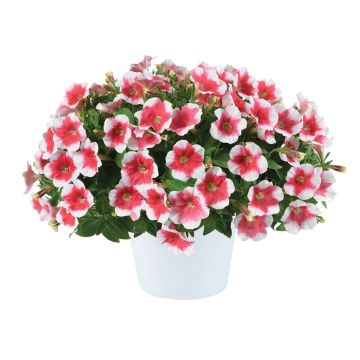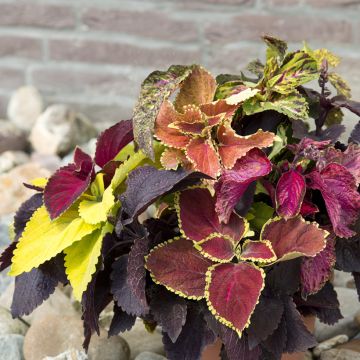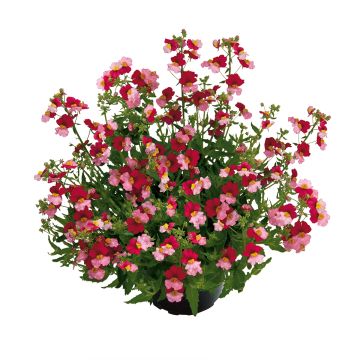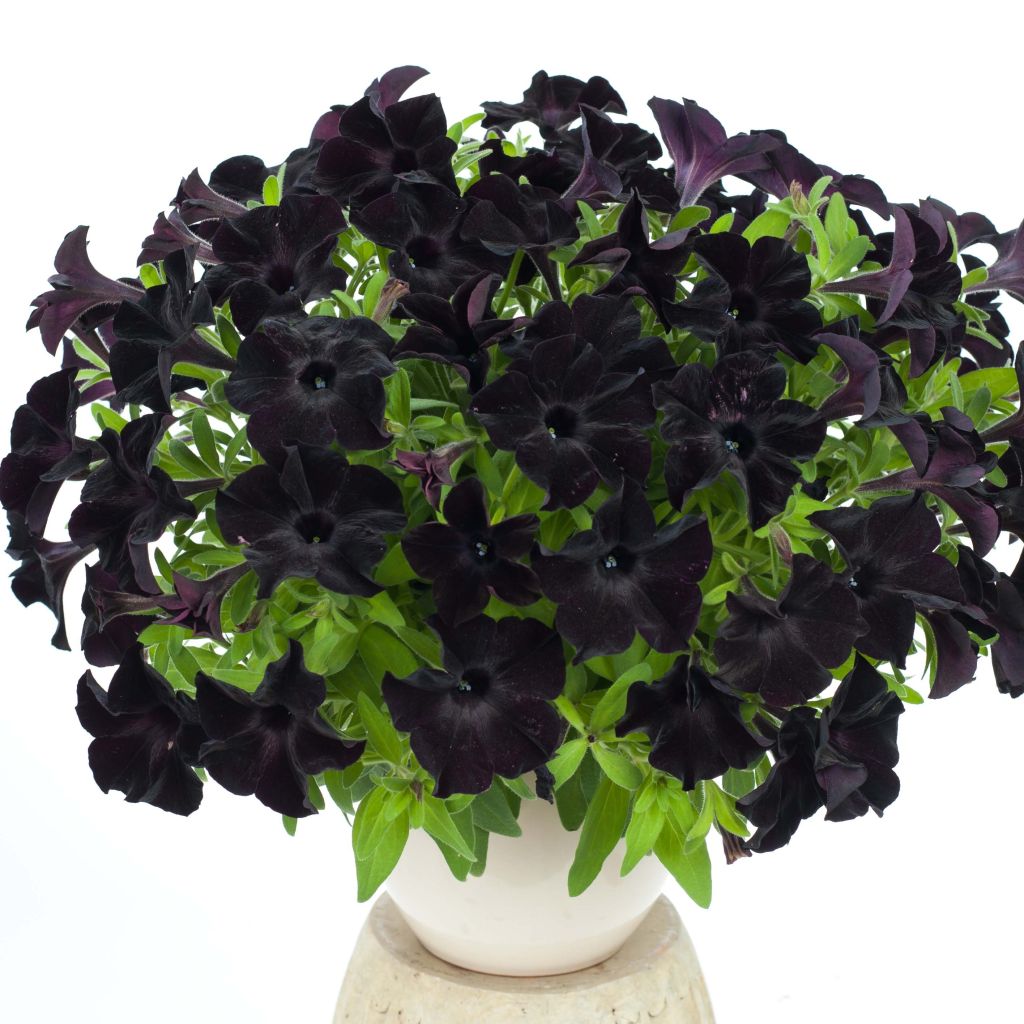

Petunia Black Ray
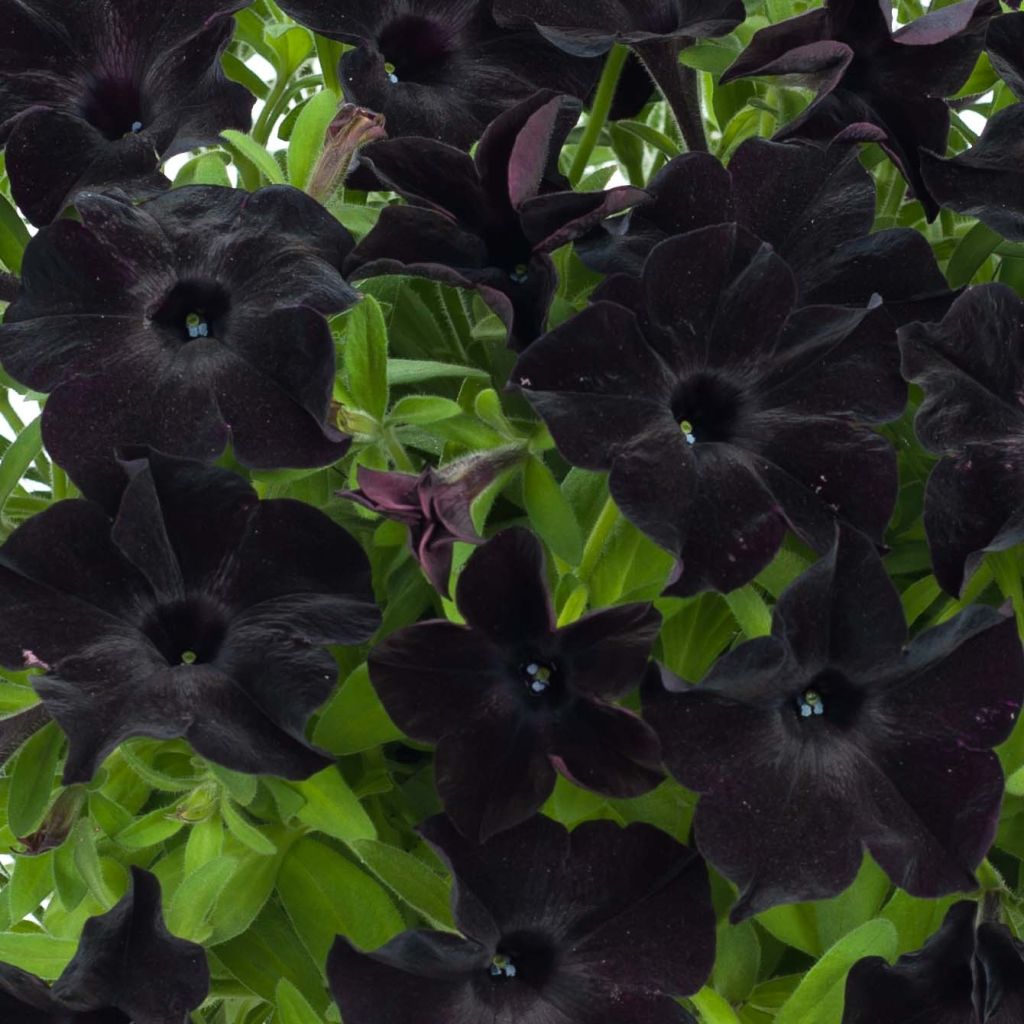

Petunia Black Ray


Petunia Black Ray
Petunia Black Ray
Petunia x hybrida Black Ray®
Petunia
This item cannot be shipped to the selected country
Delivery charge from €5.90
Delivery charge from €5.90
More information
Schedule delivery date,
and select date in basket
This plant carries a 6 months recovery warranty
More information
We guarantee the quality of our plants for a full growing cycle, and will replace at our expense any plant that fails to recover under normal climatic and planting conditions.
From €5.90 for pickup delivery and €6.90 for home delivery
Express home delivery from €8.90.
From €5.90 for pickup delivery and €6.90 for home delivery
Express home delivery from €8.90.

Does this plant fit my garden?
Set up your Plantfit profile →
Description
The Petunia Black Ray is a sumptuously black flowering plant, with large dark trumpets where the light creates silky and velvety reflections of jet black or deep purple. It is a well-branched bushy plant, forming a luxurious dome where these surprising flowers succeed each other from summer to autumn without interruption. Its flowering enhances silver foliage, pastel or vibrant colours, creating fabulous contrasts of shades or shapes. This annual plant can quickly dress up hanging baskets, garden pots, or containers.
Our hybrid petunias all come from several plants native to the warm regions of South America. Petunia Black Ray belongs to the Solanaceae family and is closely related to ornamental tobacco, for example, and its foliage also contains alkaloids. This variety quickly forms a round and regular bushy tuft, about 40 cm (15.7 in) in height and 50 cm in diameter, with a perfect dome-shaped habit that barely droops. The plant is in flower from June to October, provided that faded flowers are regularly removed and it is regularly supplied with fertiliser. Its cup-shaped flowers are large, surprising, woven with silk and velvet of a rich and deep black, sometimes showing reflections of tin, brown, and purple. The small centre of the corolla is marked with a silver reflection. The foliage, quite hairy, has entire edges and a dark green colour, it is vigorous and healthy.
No other annual flowering plant has undergone such intense selection by breeders for such a long period. The results are impressive, as petunias rival pelargoniums in their splendour and length of flowering, as evidenced by this Black Ray variety. Place it in large pots or hanging baskets. You can also plant this petunia in flower beds to punctuate borders of plants with grey foliage such as ceraistes, cineraria maritima, or artemisias. If you want to stand out, plant several young plants to form an original ground cover at the base of plants with grey foliage such as Faassen's catmints or annual poppies in pastel colours.
Note: Please be aware that our young plants in mini-pots are professional products reserved for experienced gardeners. Upon receipt, transplant and store them in shelters (veranda, greenhouse, cold frame...) at a temperature above 14°C for a few weeks before being installed outdoors once all risk of frost has passed.
Report an error about the product description
Petunia Black Ray in pictures
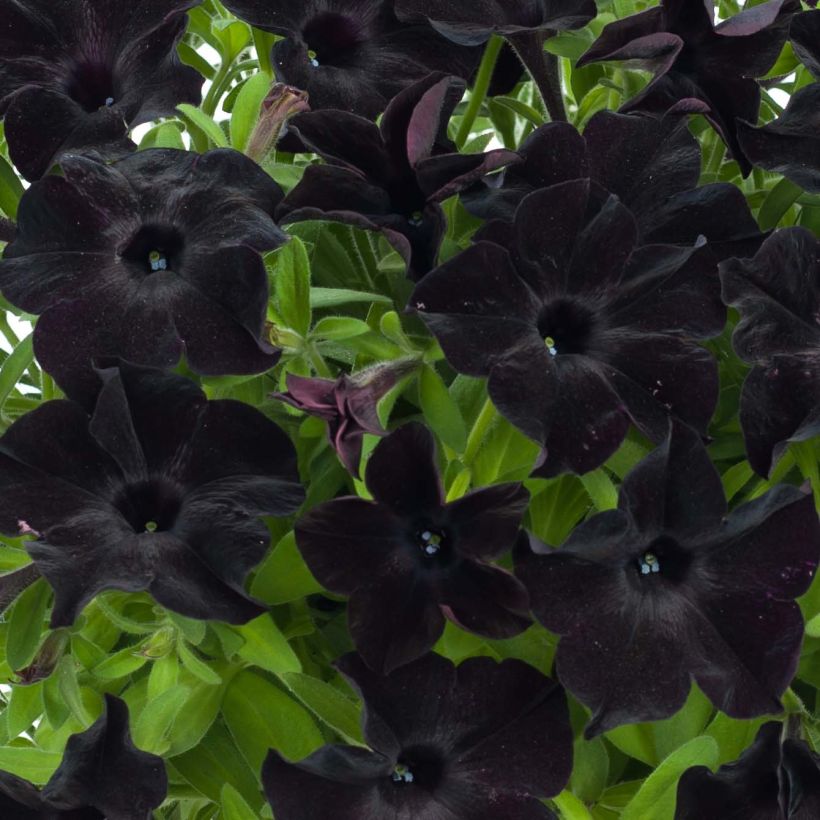



Flowering
Foliage
Plant habit
Botanical data
Petunia
x hybrida
Black Ray®
Solanaceae
Petunia
Cultivar or hybrid
Other Petunia and Surfinia
Planting and care
Plant your petunias in a sunny location or possibly in partial shade, in a sheltered spot from the wind. They need a light and humus-bearing soil and greatly appreciate fertiliser. You can plant your Petunias in a pot. They will be watered regularly. Fertiliser inputs every two weeks maintain flowering and intensify colours. Regularly remove faded flowers. Severely pinch the end of the stems to encourage the plant to branch out further.
Planting period
Intended location
Care
-
, onOrder confirmed
Reply from on Promesse de fleurs
Plug plants - Annuals
Haven't found what you were looking for?
Hardiness is the lowest winter temperature a plant can endure without suffering serious damage or even dying. However, hardiness is affected by location (a sheltered area, such as a patio), protection (winter cover) and soil type (hardiness is improved by well-drained soil).

Photo Sharing Terms & Conditions
In order to encourage gardeners to interact and share their experiences, Promesse de fleurs offers various media enabling content to be uploaded onto its Site - in particular via the ‘Photo sharing’ module.
The User agrees to refrain from:
- Posting any content that is illegal, prejudicial, insulting, racist, inciteful to hatred, revisionist, contrary to public decency, that infringes on privacy or on the privacy rights of third parties, in particular the publicity rights of persons and goods, intellectual property rights, or the right to privacy.
- Submitting content on behalf of a third party;
- Impersonate the identity of a third party and/or publish any personal information about a third party;
In general, the User undertakes to refrain from any unethical behaviour.
All Content (in particular text, comments, files, images, photos, videos, creative works, etc.), which may be subject to property or intellectual property rights, image or other private rights, shall remain the property of the User, subject to the limited rights granted by the terms of the licence granted by Promesse de fleurs as stated below. Users are at liberty to publish or not to publish such Content on the Site, notably via the ‘Photo Sharing’ facility, and accept that this Content shall be made public and freely accessible, notably on the Internet.
Users further acknowledge, undertake to have ,and guarantee that they hold all necessary rights and permissions to publish such material on the Site, in particular with regard to the legislation in force pertaining to any privacy, property, intellectual property, image, or contractual rights, or rights of any other nature. By publishing such Content on the Site, Users acknowledge accepting full liability as publishers of the Content within the meaning of the law, and grant Promesse de fleurs, free of charge, an inclusive, worldwide licence for the said Content for the entire duration of its publication, including all reproduction, representation, up/downloading, displaying, performing, transmission, and storage rights.
Users also grant permission for their name to be linked to the Content and accept that this link may not always be made available.
By engaging in posting material, Users consent to their Content becoming automatically accessible on the Internet, in particular on other sites and/or blogs and/or web pages of the Promesse de fleurs site, including in particular social pages and the Promesse de fleurs catalogue.
Users may secure the removal of entrusted content free of charge by issuing a simple request via our contact form.
The flowering period indicated on our website applies to countries and regions located in USDA zone 8 (France, the United Kingdom, Ireland, the Netherlands, etc.)
It will vary according to where you live:
- In zones 9 to 10 (Italy, Spain, Greece, etc.), flowering will occur about 2 to 4 weeks earlier.
- In zones 6 to 7 (Germany, Poland, Slovenia, and lower mountainous regions), flowering will be delayed by 2 to 3 weeks.
- In zone 5 (Central Europe, Scandinavia), blooming will be delayed by 3 to 5 weeks.
In temperate climates, pruning of spring-flowering shrubs (forsythia, spireas, etc.) should be done just after flowering.
Pruning of summer-flowering shrubs (Indian Lilac, Perovskia, etc.) can be done in winter or spring.
In cold regions as well as with frost-sensitive plants, avoid pruning too early when severe frosts may still occur.
The planting period indicated on our website applies to countries and regions located in USDA zone 8 (France, United Kingdom, Ireland, Netherlands).
It will vary according to where you live:
- In Mediterranean zones (Marseille, Madrid, Milan, etc.), autumn and winter are the best planting periods.
- In continental zones (Strasbourg, Munich, Vienna, etc.), delay planting by 2 to 3 weeks in spring and bring it forward by 2 to 4 weeks in autumn.
- In mountainous regions (the Alps, Pyrenees, Carpathians, etc.), it is best to plant in late spring (May-June) or late summer (August-September).
The harvesting period indicated on our website applies to countries and regions in USDA zone 8 (France, England, Ireland, the Netherlands).
In colder areas (Scandinavia, Poland, Austria...) fruit and vegetable harvests are likely to be delayed by 3-4 weeks.
In warmer areas (Italy, Spain, Greece, etc.), harvesting will probably take place earlier, depending on weather conditions.
The sowing periods indicated on our website apply to countries and regions within USDA Zone 8 (France, UK, Ireland, Netherlands).
In colder areas (Scandinavia, Poland, Austria...), delay any outdoor sowing by 3-4 weeks, or sow under glass.
In warmer climes (Italy, Spain, Greece, etc.), bring outdoor sowing forward by a few weeks.







































